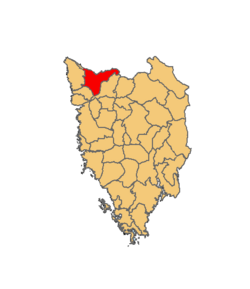Buje Buie | |
|---|---|
Town | |
| Town of Buje Grad Buje - Città di Buie [1] | |
 | |
 Location of Buje municipality in Istria | |
| Coordinates: 45°25′N13°40′E / 45.417°N 13.667°E | |
| Country | |
| Region | Istria |
| County | |
| Government | |
| • Mayor | Fabrizio Vižintin (IDS) |
| Area | |
• Town | 38.3 sq mi (99.2 km2) |
| • Urban | 6.4 sq mi (16.5 km2) |
| Population (2021) [3] | |
• Town | 4,441 |
| • Density | 120/sq mi (45/km2) |
| • Urban | 2,087 |
| • Urban density | 330/sq mi (130/km2) |
| Time zone | UTC+1 (CET) |
| • Summer (DST) | UTC+2 (CEST) |
| Website | buje |
Buje (Italian : Buie; [4] Venetian : Buje) is a town situated in Istria, Croatia's westernmost peninsula.
Contents
Buje was known as the "sentinel of Istria" for its hilltop site located 10 km (6.2 mi) inland from the Adriatic Sea.




